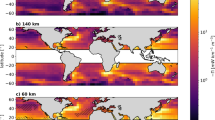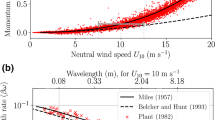Abstract
Two of the best available observed frequency spectra of energy-containing oceanic motions are summarized. Without provoking any simple explanation, they affirm that an efficient, homogeneous cascade of energy to small scales isnot occurring. The way is left open for interpretation as a mixture of geostrophic turbulence and waves.
Detailed models are given which yield plausible behavior of various parts of the wave-number and frequency spectra, and illustrate the workings of nonlinearity and wave dispersion: (i) simple dispersion of linear, wind-generated internal waves gives at depths an inertial peak and a steeply sloping high-frequency spectrum (the inertial peak at the very top of the ocean is a direct response of the mixed layer to the wind); (ii) at longer periods,two-dimensional turbulence subjected to the beta effect produces well-ordered motions from a chaotic initial state, with dominant length and time-scale independent of initial conditions. The turbulence evolves quickly and naturally into Rossby waves, leaving a peaky, quasi-stationary spectrum; (iii) inone dimension, the Korteweg de Vries equation again shows how waves may sharpen and fix the wave-number spectrum while dispersing the energy in physical space; (iv) possible application of the ideas tothree-dimensional turbulence and waves is discussed.
The most general result is that the scale-dependent boundary, at which the wave steepness is about unity, often divides energy-frequency/wave-number space into regions in which the mobility of energy is vastly different; depending on the direction and speed of nonlinear migration within these regions, energy may pile up at this boundary. Thus, wave-restoring forces can concentrate spectra at certain wave numbers while dispersing the fields in physical space.
Similar content being viewed by others
References
Garrett, C. and Munk, W.: 1972, ‘Space-Time Scales of Internal Waves’,Geophys. Fluid Dyn. 2, 225.
Halpern, D.: 1971, ‘Observations on Short-Period Internal Waves in Massachusetts Bay’,J. Marine Res. 29, 116.
Haurwitz, B., Stommel, H., and Munk, W.: 1959, ‘The Thermal Unrest of the Ocean’, pp. 74–94, inThe Atmosphere and the Sea in Motion, Rockefeller Press, New York.
Lilly, D. K.: 1970, ‘Numerical Simulation of Developing and Decaying Two-Dimensional Turbulence’,J. Fluid Mech. 45, 395.
Phillips, O. M.: 1966, inDynamics of the Upper Ocean, Cambridge Press, p. 234.
Pollard, R., Rhines, P., and Thompson, R. O. R. Y.: 1972, ‘The Deepening of the Wind-mixed Layer’,Geophys. Fluid Dyn., in press.
Rhines, P. B.: 1970, ‘Edge-, Bottom-, and Rossby Waves in a Rotating Stratified Fluid’,Geophys. Fluid Dyn. 1, 273.
Rhines, P. B.: 1971, ‘A Note on Long-Period Motions at Site D’,Deep-Sea Res. 18, 21.
Rhines, P. B.: 1972, ‘Large-Scale Turbulence: Evolution into Waves in the Oceans and Atmosphere’, (submitted for publication).
Thompson, R.: 1971, ‘Topographic Rossby Waves at a Site North of the Gulf Stream’,Deep-Sea Res. 18, 1.
Webster, F.: 1969, ‘Turbulence Spectra in the Ocean’,Deep-Sea Res. 16, 357.
Wunsch, C.: 1972, ‘The Spectrum of Temperature near Bermuda from Two Minutes to Two Years’, (submitted for publication).
Author information
Authors and Affiliations
Additional information
Now at Woods Hole Oceanographic Institution.
Rights and permissions
About this article
Cite this article
Rhines, P. Observations of the energy-containing oceanic Eddies, and theoretical models of waves and turbulence. Boundary-Layer Meteorol 4, 345–360 (1973). https://doi.org/10.1007/BF02265243
Received:
Issue Date:
DOI: https://doi.org/10.1007/BF02265243




